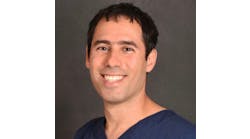A team of radiology leaders from the island-nation of Singapore gave a group presentation on Tuesday, Nov. 28, during RSNA23, the annual conference of the Oak Brook, Ill.-based Radiological Society of North America, being held this week at Chicago’s vast McCormick Place Convention Center. The Singaporean team shared a wealth of information about Singapore, its healthcare system, and the role of radiologists in that system, with a perspectives on how radiologists in that country are peering towards the future and envisioning what kind of role their medical specialty will play, in a shifting demographic, reimbursement, clinical, operational, and technological environment. The session, entitled “Radiology in the Lion City: The Pursuit of Excellence Within 284 Square Miles,” provided RSNA attendees with a fascinating look at a healthcare system with parallel challenges to those of the United States, in the context of a different nation and a different society.
Charles Xian-Yang Goh, MMed, a specialist in nuclear medicine and molecular imaging at Singapore General Hospital, introduced the geography and demographics of Singapore, an island city in Southeast Asia with a population of more than 5.9 million people in a land area of less than 284 square miles (734 square kilometers), making it one of the most densely populated nations on earth. Indeed, it was noted at the beginning of the session that the island-nation of Singapore is smaller than the area spanning McCormick Place and O’Hare International Airport in Chicago.
One of several presenters, Dr. Goh began by providing the audience with basic facts about the Singaporean healthcare system, which is a mixed model involving medical clinics that are 80-percent private, while the island nation’s hospitals are privately run but government-owned. Health insurance is compulsory for citizens, but with heavy subsidies for citizens and permanent residents, along with requirements for co-pays.
The two huge challenges, Goh noted, are an exploding age curve, with 51 percent of the population of Singapore expected to be over 65 years of age by 2026, and, parallel to most other advanced nations, an explosion in rates of chronic illness, with 37 percent of the population experiencing hypertension and 31.9 percent experiencing hyperlipidemia. The government has embarked on Healthier SG, a campaign to shift the care delivery model as much as possible towards preventive and primary care, along with an emphasis on lifestyle changes and chronic disease management. At the same time, he noted, the policy consensus has been to foster a shift away from fee-for-service reimbursement and towards capitation. Among the implications of all that, he said, will be a strong shift in emphasis for diagnostic imaging to support screening for illness.
Dr. Goh was followed on the podium by Cher Heng Tan, MBBS, FRCR, a senior consultant at Tan Tock Seng Hospital, and a specialist in body imaging and oncologic imaging. In his presentation, Dr. Tan referenced the development of the “ACUITy” program, which involves the leveraging of appropriateness criteria, saying, “We will need to increase appropriateness criteria for imaging use.” Per that, he said, “We’ve been working with a list so far of 200 appropriate-use criteria; we’ve been seeking local consensus” on how to move forward.” And, per that, he reported, “We formed three separate committees to look at inappropriate use of MR for the lumbar spine—and have reduced the volume of such procedures by half.” Another win has come in the creation of guidelines for the administration of chest x-rays, which had been routinely been prescribed to young people matriculating in local universities. “The development of chest x-ray guidelines has led to the avoidance of pre-enrollment chest x-rays for entering university students who are asymptomatic.”
More broadly, Tan reported, government officials in Singapore have made the development of AI for clinical purposes a national priority, creating a national platform for clinical AI development called AimSG, with AimSG being hosted by the national health technology agency, Synapxe. The AimSG solution is still being tested, but Synapxe will be deploying it across the nation’s hospitals and clinics over time. Regarding clinical AI development, he said, “The question is, does it create value in the clinical workflow?” It will be on that basis that AI will be developed in Singapore, going forward. The good news? “Radiology in Singapore is fully digitalized and well-positioned to capture opportunities in technology advancement,” he said. “And it could alleviate issues of manpower shortage while improving frontline care delivery.”
Tan was followed by Lionel Cheng, MMed, FRCR, MBBS, chief data and digital officer at Singapore General Hospital, and a practicing radiologist specializing in body radiology. Dr. Cheng addressed some of the staffing and workload issues facing radiologists in Singapore. On the one hand, the number of diagnostic radiologists has increased an average of 9.9 percent per year since 2010, when there were just 211 practicing diagnostic radiologists in the country at that time; as of 2021, there were 441. That figure puts Singapore above the median of radiologist availability per population, globally: the global average is 45 radiologists per million population. “We’re at 61,” he noted, “which is above average, and similar to Australia, New Zealand, and Europe.” The figure for North America is 116; for Africa, just 41. And, he added, “If all goes well, we will have about 700 radiologists by around 2030.”
What’s more, Cheng noted, “We really will have to move from progressive subspecialization to adaptive diversification. Precision radiology and population radiology” are in our future as a nation. In other words, “We need to go beyond pixels to prediction.”
Per that, he added, “In the future workforce, we need to continue to add value, to… push frontiers to expand the radiology capability spectrum and leverage hyperconnectivity on our island to drive new national level subspecialty services, to push forward on precision radiology—to move from pixels to prophecy. And we will need to advance new ground, and define the role of radiologists in population health management.”


